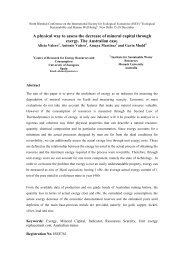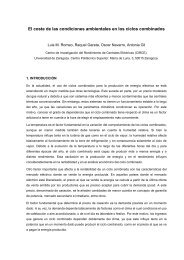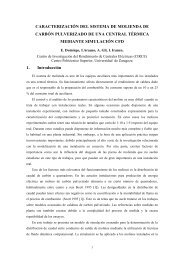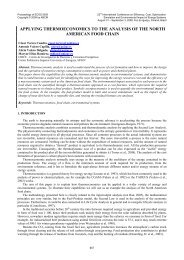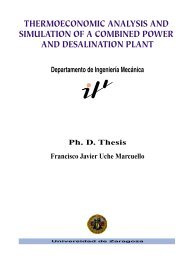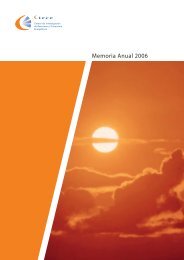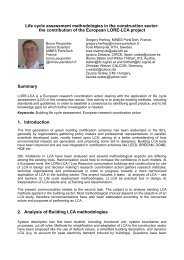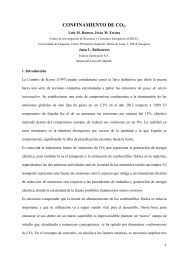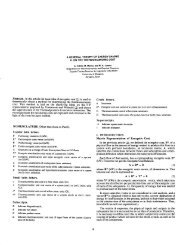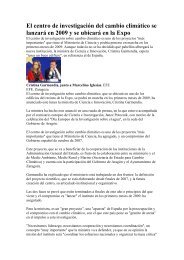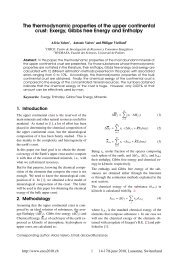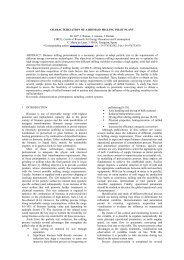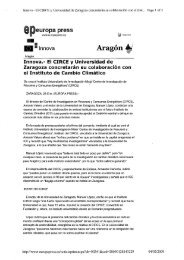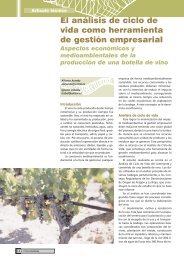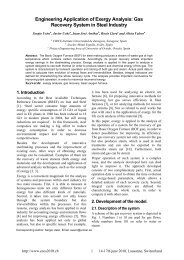Exergy evolution of the mineral capital on earth - circe
Exergy evolution of the mineral capital on earth - circe
Exergy evolution of the mineral capital on earth - circe
You also want an ePaper? Increase the reach of your titles
YUMPU automatically turns print PDFs into web optimized ePapers that Google loves.
12 STARTING POINT, OBJECTIVES AND SCOPE<br />
Additi<strong>on</strong>ally, two PhD <str<strong>on</strong>g>the</str<strong>on</strong>g>sis accomplished in <str<strong>on</strong>g>the</str<strong>on</strong>g> CIRCE institute <str<strong>on</strong>g>of</str<strong>on</strong>g> <str<strong>on</strong>g>the</str<strong>on</strong>g> University <str<strong>on</strong>g>of</str<strong>on</strong>g><br />
Zaragoza and directed by Ant<strong>on</strong>io Valero, have applied and have fur<str<strong>on</strong>g>the</str<strong>on</strong>g>r developed<br />
<str<strong>on</strong>g>the</str<strong>on</strong>g> exergoecology approach. The first <strong>on</strong>e entitled “Análisis De Los Costes Exergéticos<br />
De La Riqueza Mineral Terrestre. Su Aplicación Para La Gestión De La Sostenibilidad”<br />
[276] (<str<strong>on</strong>g>Exergy</str<strong>on</strong>g> cost analysis <str<strong>on</strong>g>of</str<strong>on</strong>g> <str<strong>on</strong>g>the</str<strong>on</strong>g> <str<strong>on</strong>g>mineral</str<strong>on</strong>g> wealth <strong>on</strong> <strong>earth</strong>. Applicat<strong>on</strong> for <str<strong>on</strong>g>the</str<strong>on</strong>g><br />
management <str<strong>on</strong>g>of</str<strong>on</strong>g> sustainability), was carried out by Lidia Ranz in 1999. The sec<strong>on</strong>d<br />
<strong>on</strong>e was written by Edgar Botero <strong>on</strong>e year later: “Valoración Exergética De Recursos<br />
Naturales, Minerales, Agua y Combustibles Fósiles” [34] (<str<strong>on</strong>g>Exergy</str<strong>on</strong>g> assessment <str<strong>on</strong>g>of</str<strong>on</strong>g><br />
natural resources, <str<strong>on</strong>g>mineral</str<strong>on</strong>g>s, water and fossil fuels).<br />
Ranz developed an approximati<strong>on</strong> <str<strong>on</strong>g>of</str<strong>on</strong>g> <str<strong>on</strong>g>the</str<strong>on</strong>g> R.E., based <strong>on</strong> <str<strong>on</strong>g>the</str<strong>on</strong>g> methodology proposed<br />
by Szargut [336] and calculated <str<strong>on</strong>g>the</str<strong>on</strong>g> chemical exergy <str<strong>on</strong>g>of</str<strong>on</strong>g> some important <str<strong>on</strong>g>mineral</str<strong>on</strong>g><br />
commodities. Her reference envir<strong>on</strong>ment was chosen according to <str<strong>on</strong>g>the</str<strong>on</strong>g> abundance<br />
criteri<strong>on</strong>, i.e. <str<strong>on</strong>g>the</str<strong>on</strong>g> comp<strong>on</strong>ents <str<strong>on</strong>g>of</str<strong>on</strong>g> <str<strong>on</strong>g>the</str<strong>on</strong>g> R.E. should be <str<strong>on</strong>g>the</str<strong>on</strong>g> most abundant <strong>on</strong>es found<br />
currently in nature. For that purpose, she carried out a comprehensive and systematic<br />
analysis <str<strong>on</strong>g>of</str<strong>on</strong>g> <str<strong>on</strong>g>the</str<strong>on</strong>g> most abundant <str<strong>on</strong>g>mineral</str<strong>on</strong>g>s <strong>on</strong> <strong>earth</strong> for each chemical element. An<br />
important message <str<strong>on</strong>g>of</str<strong>on</strong>g> her study was that exergoecology is irrevocably c<strong>on</strong>nected to<br />
geology. A problem with Ranz’s proposed R.E. is that if we assign zero exergy to <str<strong>on</strong>g>the</str<strong>on</strong>g><br />
most abundant substances, we are decreasing arbitrarily <str<strong>on</strong>g>the</str<strong>on</strong>g> natural <str<strong>on</strong>g>capital</str<strong>on</strong>g>, because<br />
many abundant <str<strong>on</strong>g>mineral</str<strong>on</strong>g>s like sulfides naturally evolute to <str<strong>on</strong>g>the</str<strong>on</strong>g> most stable species.<br />
Botero extended <str<strong>on</strong>g>the</str<strong>on</strong>g> exergy analysis to o<str<strong>on</strong>g>the</str<strong>on</strong>g>r natural resources such as water and<br />
fossil fuels. In his PhD, <str<strong>on</strong>g>the</str<strong>on</strong>g> c<strong>on</strong>cept <str<strong>on</strong>g>of</str<strong>on</strong>g> exergy replacement costs was fur<str<strong>on</strong>g>the</str<strong>on</strong>g>r developed,<br />
and <str<strong>on</strong>g>the</str<strong>on</strong>g> exergy abatement costs, were firstly applied. The exergy replacement cost<br />
was first calculated as <str<strong>on</strong>g>the</str<strong>on</strong>g> exergy required for replacing a resource from <str<strong>on</strong>g>the</str<strong>on</strong>g> R.E.<br />
to <str<strong>on</strong>g>the</str<strong>on</strong>g> current c<strong>on</strong>diti<strong>on</strong>s found in nature, with <str<strong>on</strong>g>the</str<strong>on</strong>g> best available technology. The<br />
exergy abatement cost was proposed as a physical way to measure <str<strong>on</strong>g>the</str<strong>on</strong>g> exergy cost for<br />
avoiding <str<strong>on</strong>g>the</str<strong>on</strong>g> envir<strong>on</strong>mental externalities associated to <str<strong>on</strong>g>the</str<strong>on</strong>g> use <str<strong>on</strong>g>of</str<strong>on</strong>g> fossil fuels, with<br />
<str<strong>on</strong>g>the</str<strong>on</strong>g> best available technology.<br />
Both PhD <str<strong>on</strong>g>the</str<strong>on</strong>g>sis, <str<strong>on</strong>g>the</str<strong>on</strong>g> book <str<strong>on</strong>g>of</str<strong>on</strong>g> Naredo and Valero [239], and <str<strong>on</strong>g>the</str<strong>on</strong>g> first paper describing<br />
<str<strong>on</strong>g>the</str<strong>on</strong>g> exergoecological method (Valero [365]), c<strong>on</strong>stitute <str<strong>on</strong>g>the</str<strong>on</strong>g> basis and starting point<br />
<str<strong>on</strong>g>of</str<strong>on</strong>g> <str<strong>on</strong>g>the</str<strong>on</strong>g> present study. The fundamental c<strong>on</strong>cepts described in <str<strong>on</strong>g>the</str<strong>on</strong>g> previous works are<br />
used in this <str<strong>on</strong>g>the</str<strong>on</strong>g>sis and are fur<str<strong>on</strong>g>the</str<strong>on</strong>g>r developed.<br />
1.6 Scope, objectives and structure <str<strong>on</strong>g>of</str<strong>on</strong>g> this PhD<br />
The aim <str<strong>on</strong>g>of</str<strong>on</strong>g> this PhD is <str<strong>on</strong>g>the</str<strong>on</strong>g> analysis <str<strong>on</strong>g>of</str<strong>on</strong>g> <str<strong>on</strong>g>the</str<strong>on</strong>g> state <str<strong>on</strong>g>of</str<strong>on</strong>g> <str<strong>on</strong>g>the</str<strong>on</strong>g> <str<strong>on</strong>g>mineral</str<strong>on</strong>g>’s exergy <strong>on</strong> <strong>earth</strong> and<br />
its degradati<strong>on</strong> velocity, due to <str<strong>on</strong>g>the</str<strong>on</strong>g> human acti<strong>on</strong>. As opposed to Botero’s and Ranz’s<br />
PhDs, where <str<strong>on</strong>g>the</str<strong>on</strong>g> exergoecological analysis was applied in a static way, in this <str<strong>on</strong>g>the</str<strong>on</strong>g>sis<br />
<str<strong>on</strong>g>the</str<strong>on</strong>g> time factor c<strong>on</strong>stitutes a fundamental variable. For that purpose, an exhaustive<br />
analysis <str<strong>on</strong>g>of</str<strong>on</strong>g> <str<strong>on</strong>g>the</str<strong>on</strong>g> geochemistry <str<strong>on</strong>g>of</str<strong>on</strong>g> our planet and its past, current and future declining<br />
resources needs to be carried out.



